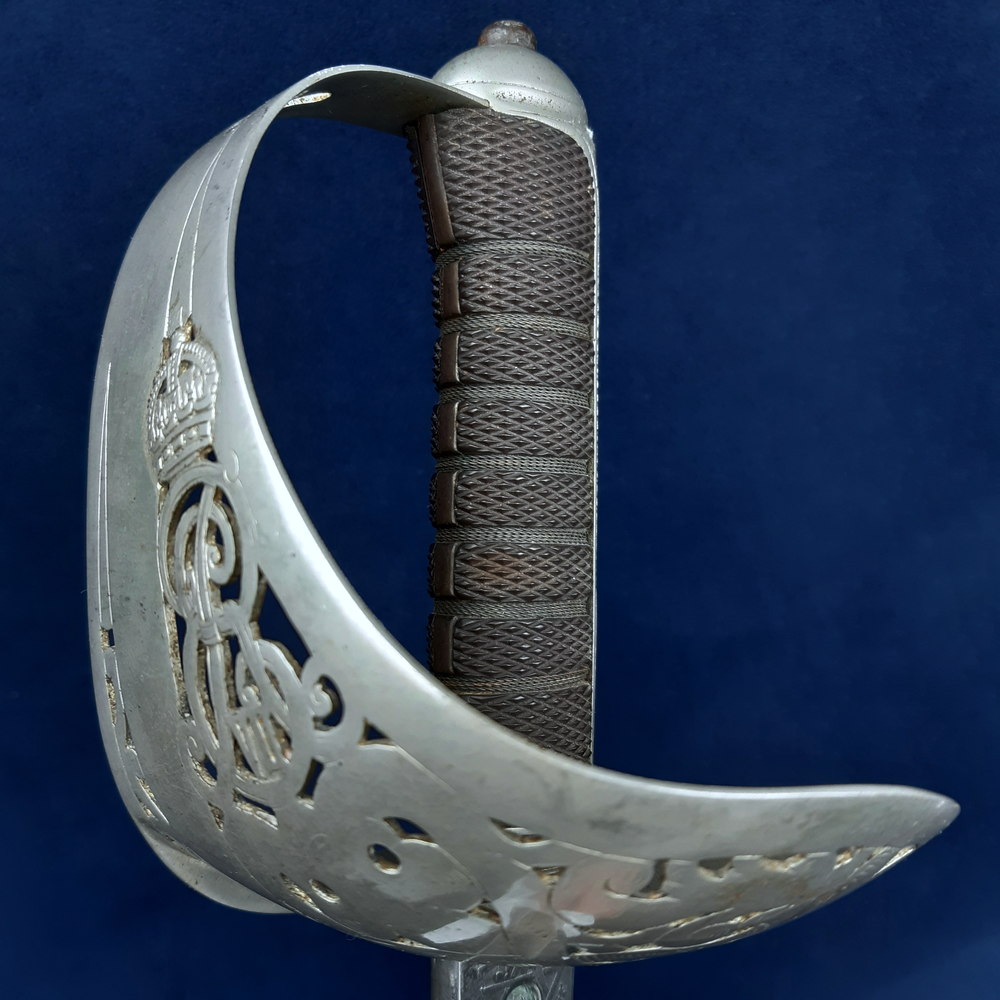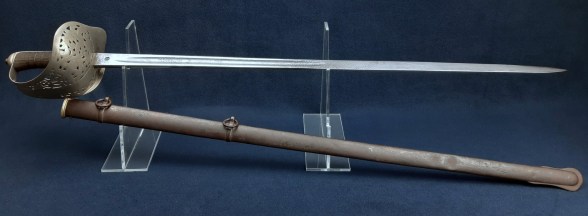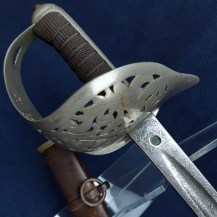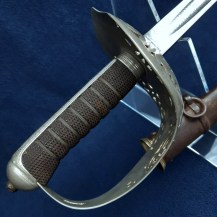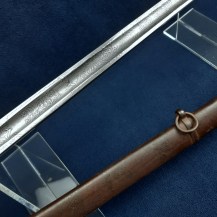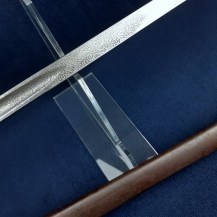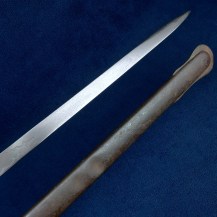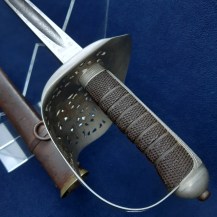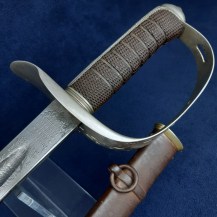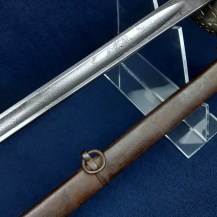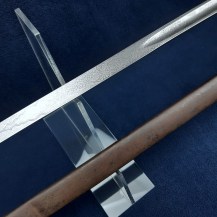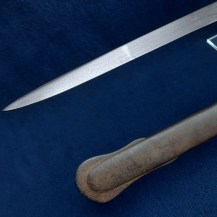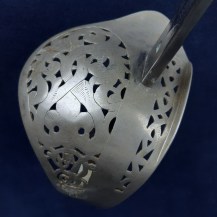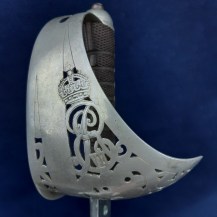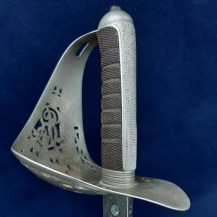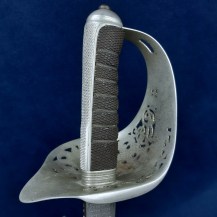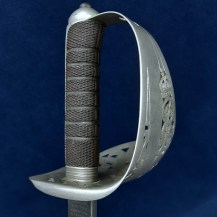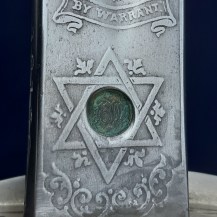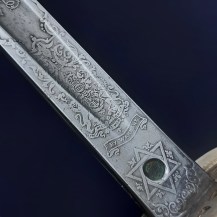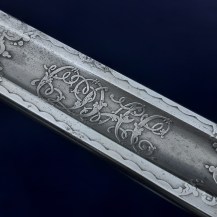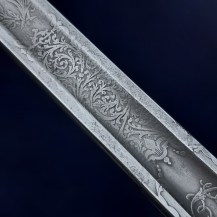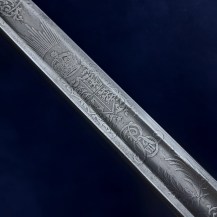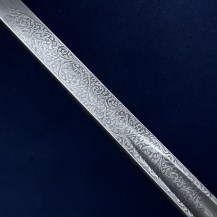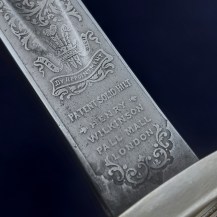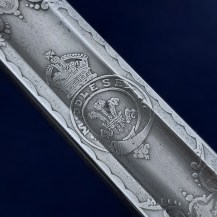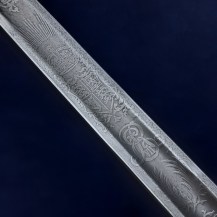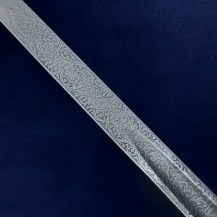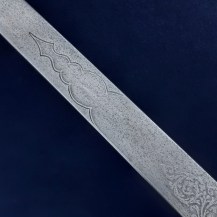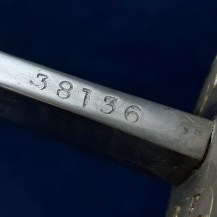British Boer War 1897 Pattern Patent Solid Hilt Infantry Officer’s Sword of Lieutenant Claud D’Arcy Cayley, Middlesex Regiment
Straight single-fullered spear-pointed blade. Steel hilt with pierced decoration including the crown and royal cypher of King Edward VII. Fully chequered backstrap, integral oval pommel with tang button. ‘Patent Solid Hilt’ of chequered grip scales bound to an exposed full-width tang and wrapped with wire. No leather washer. Steel parade scabbard with brass throat piece and two hanging rings. Blade 32 inches in length, 1 1/16 inches wide at the shoulder, the sword 38 inches overall.
On one side the blade bears a brass proof slug at the ricasso stamped with ‘HW’, within an etched six-pointed star. Above this is etched the royal coat of arms and ‘BY WARRANT’, the crown, shield and cypher of Edward VII, and foliate motifs. There is a cartouche for the optional etching of the owner’s name, which has been filled with ‘CDAC’ in ornate script.
On the other side the blade is etched at the ricasso on one side with ‘PATENT SOLID HILT’ and the maker’s mark ‘HENRY WILKINSON PALL MALL LONDON’. Above this is etched the coat of arms of the Prince of Wales with ‘BY APPOINTMENT’, the regimental badge of the Middlesex Regiment (the crown and feathers of the Prince of Wales within a garter which reads ‘MIDDLESEX’, surmounted by a crown), the crown, shield and cypher of Edward VII once again, and foliate motifs.
Claud D’Arcy Cayley was born in 1882 in Bromley, Kent. His family descended from the youngest son of Sir William Cayley, who was awarded a baronetcy in 1661 for fighting for the Royalist cause in the Civil War. His father Claud Thornton Cayley was an engineer and importer of American-made engineering machinery who went on to establish The Projectile Co. Limited, which manufactured machinery, automobiles, artillery shells and torpedoes, with several contracts for the latter with the US Navy. The enterprise appears to have made the elder Claud a wealthy man with numerous properties.
Claud became a 2nd Lieutenant in the 5th Battalion of the Duke of Cambridge’s Own (Middlesex Regiment) in October 1901. Wilkinson Sword records indicate that sword #38136, listed as a ‘Patent Tang Infantry Sword’ was sold to ‘C. D. A. Caley 5th Middlesex Regt’ [sic] on the 20th June 1900.
There is an interesting small mismatch here: a sword sold in June 1900 (under Queen Victoria) to an officer serving from October 1901, with the cypher of Edward VII who reigned from January 1901. It may have been that the sword was ordered in 1900 in expectation of Claud’s enlistment but not completed until 1901 under the new King. Due to the ongoing Boer War Wilkinson experienced a high volume of orders which may have slowed deliveries. The 1901 census registers Claud living in Battersea, staying with the Jewson family, perhaps as a lodger.
Claud served in South Africa in 1902, taking part in operations in the Transvaal and Cape Colony. Burke’s Peerage attests that he did attain the rank of Lieutenant, but I can find no other record of this promotion.
Records of Claud’s life are very sparse – after leaving the Army he may have become a civil servant. His son was born in August 1918 in Singapore, so he may have spent time on foreign service. There is no indication of him serving in the military in WW1. He is recorded as reentering the UK in 1921. As of 1939 he lived in Hatfield, Hertfordshire, where he was active in his local council. Claud died in 1948, aged 66.
Developed by swordsmith Charles Reeves, who obtained a patent on the design in 1853, the ‘Patent Solid Hilt’ incorporated a tang that ran the full width of a sword’s grip. A full-width tang resulted in a stronger weapon, a common point of breakage being at the shoulder where the blade would traditionally abruptly narrow into a slender tang that ran through the centre of the grip. The Patent hilt was a relatively expensive optional extra applied to an individual officer’s sword upon request at the point of purchase. Applied to various sword Patterns over the years, it made sense as a purchase for an officer who was expecting serious combat or had disposable income for a top-of-the-line weapon: Claud would clearly fall into both categories. By the time of this sword’s purchase Wilkinson was the holder of the patent, having absorbed Reeves’s company in the 1880s.
The blade has no damage to its edge and only a few tiny spots of patination, some of these among the etching. The etching is crisp with some very light rubbing to the foliate pattern beyond the end of the fuller due to sheathing and drawing. Some light verdigris to the proof slug. The chequered grip is all intact and its diamonds sharp with no notable handling wear, the wire binding is all present and tight. The exposed tang of the blade has an even grey patina. The nickel plating of the hilt parts is very good with only a few tiny specks of wear revealing patinated steel in the usual areas including inside the guard where fingers would rub against it when carried. Some tiny spots of staining on the outer guard.
The scabbard is darkly and evenly patinated overall with only its brass mouthpiece bright. Some patches of moderate pitting to the steel body with spots of heavy pitting near the chape. Some horizontal dents to the scabbard near the chape on both sides, these do not interfere with sheathing and drawing.

